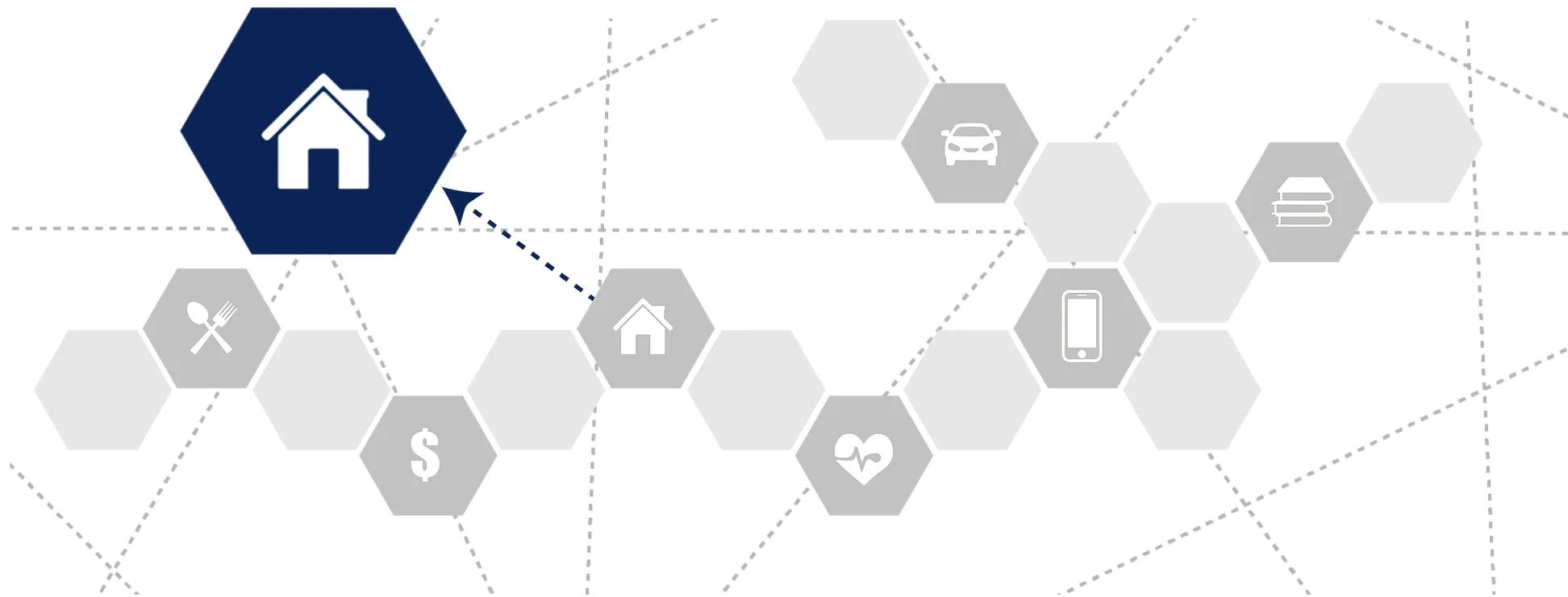
|
Housingclick to view |

|
Health Careclick to view |

|
Child Care and Educationclick to view |

|
Technologyclick to view |

|
Foodclick to view |

|
Taxesclick to view |

|
Transportationclick to view |
||
Impact on ALICE
What do families do if they can’t afford adequate housing?
Despite wide national variation, housing costs for renters and owners consistently outpace wages. Faced with high housing costs, most ALICE households are considered housing burdened, meaning that housing costs more than 30 percent of their income. In 2017, households with lower incomes (less than $50,000 per year) were more likely to be housing burdened than those with higher incomes (above $75,000) across all housing types.
- Nearly three out of four lower-income renters — and the same share of lower-income owners with a mortgage — were housing burdened.
- The states with the highest rates of housing-burdened renters were California (53 percent), Florida (52 percent), and Hawai‘i (52 percent). North Dakota had the lowest rate at 37 percent.7
Pay More Than Budget Allows
With the cost of housing consuming so much of a family’s budget, ALICE families almost always have to make sacrifices in other areas.
With the cost of housing consuming so much of a family’s budget, ALICE families almost always have to make sacrifices in other areas.

Live in Less Desirable Locations
The cost — and quality — of housing varies greatly depending on location. For many ALICE families, the only housing they can afford is located in less desirable areas. These areas typically have one or more of the following issues: high crime rates, run-down infrastructure, little to no public transportation, or lower-quality schools. They are also often located far from jobs, full-service grocery stores, public services (such as parks and post offices), and other necessities.
The cost — and quality — of housing varies greatly depending on location. For many ALICE families, the only housing they can afford is located in less desirable areas. These areas typically have one or more of the following issues: high crime rates, run-down infrastructure, little to no public transportation, or lower-quality schools. They are also often located far from jobs, full-service grocery stores, public services (such as parks and post offices), and other necessities.

Rent or Buy Substandard Housing
Given the high cost of quality housing, ALICE families are often forced to choose homes that are in substandard condition. Such housing presents a variety of health and safety risks including malfunctioning or absent heating, ventilation, and air conditioning systems; sub-par plumbing and leaks; and exposure to vermin or lead, mold, and other toxins.22 In the U.S., 5 percent of the housing stock has severe problems, such as issues with plumbing, heating, or cleanliness.23
Given the high cost of quality housing, ALICE families are often forced to choose homes that are in substandard condition. Such housing presents a variety of health and safety risks including malfunctioning or absent heating, ventilation, and air conditioning systems; sub-par plumbing and leaks; and exposure to vermin or lead, mold, and other toxins.22 In the U.S., 5 percent of the housing stock has severe problems, such as issues with plumbing, heating, or cleanliness.23

Seek Housing Assistance
Another option is to seek homeowner or rental assistance. While a large number of ALICE households depend on this kind of assistance, it remains unavailable to many others. Approximately 4.8 million households (about 4 percent of all U.S. households) receive homeowner or rental assistance from the U.S. Department of Housing and Urban Development (HUD).29 Yet only one-quarter of households eligible for federal rental housing assistance actually receive it. Federal housing subsidies:
Another option is to seek homeowner or rental assistance. While a large number of ALICE households depend on this kind of assistance, it remains unavailable to many others. Approximately 4.8 million households (about 4 percent of all U.S. households) receive homeowner or rental assistance from the U.S. Department of Housing and Urban Development (HUD).29 Yet only one-quarter of households eligible for federal rental housing assistance actually receive it. Federal housing subsidies:
- Go disproportionately to higher-income households
- Are deeply underfunded for rental assistance30

Borrow At Higher Rates
ALICE families may decide to take out a high-interest loan to purchase a home. This option could be less expensive than renting in some locations, and offers a way to build equity. However, many potential ALICE homeowners do not qualify for competitive financing rates or do not have savings for a down payment. So that for ALICE households to buy, they are often forced to borrow at high rates or use risky financial products, with potential long-term consequences.35 Nationally, the two most common reasons renters cite for renting rather than owning a home are that they don’t think they can afford the down payment (50 percent of respondents) or they don’t believe that they will qualify for a mortgage (31 percent).36
ALICE families may decide to take out a high-interest loan to purchase a home. This option could be less expensive than renting in some locations, and offers a way to build equity. However, many potential ALICE homeowners do not qualify for competitive financing rates or do not have savings for a down payment. So that for ALICE households to buy, they are often forced to borrow at high rates or use risky financial products, with potential long-term consequences.35 Nationally, the two most common reasons renters cite for renting rather than owning a home are that they don’t think they can afford the down payment (50 percent of respondents) or they don’t believe that they will qualify for a mortgage (31 percent).36

Sources
7
American Community Survey. (2017). Percent of renter-occupied units spending 30 percent or more of household income on rent and utilities. Retrieved from https://factfinder.census.gov/bkmk/table/1.0/en/ACS/17_1YR/GCT2515.US01PR
Fischer, W., & Sard, B. (2016). Chart book: Federal housing spending is poorly matched to need. Center on Budget and Policy Priorities. Retrieved from https://www.cbpp.org/research/housing/chart-book-federal-housing-spending-is-poorly-matched-to-need
8
Joint Center for Housing Studies of Harvard University. (2018). The state of the nation’s housing 2018. Retrieved from https://www.jchs.harvard.edu/sites/default/files/Harvard_JCHS_State_of_the_Nations_Housing_2018.pdf
9
Joint Center for Housing Studies of Harvard University. (2018). The state of the nation’s housing 2018. Retrieved from https://www.jchs.harvard.edu/sites/default/files/Harvard_JCHS_State_of_the_Nations_Housing_2018.pdf
10
American Housing Survey. (2017). Delinquent payments and notices — All occupied units. Retrieved from https://www.census.gov/programs-surveys/ahs.html
11
ATTOM Data Solutions. (2018). U.S. foreclosure activity drops to 12-year low in 2017. Retrieved from https://www.attomdata.com/news/foreclosure-trends/2017-year-end-u-s-foreclosure-market-report/
12
Morgan, R. E., & Truman, J. L. (2018, December). Criminal victimization, 2017. Department of Justice, Office of Justice Programs, Bureau of Justice Statistics. Retrieved from https://www.bjs.gov/content/pub/pdf/cv17.pdf
13
Joint Center for Housing Studies at Harvard University. (2016). The state of the nation’s housing 2016. Retrieved from http://www.jchs.harvard.edu/sites/jchs.harvard.edu/files/jchs_2016_state_of_the_nations_housing_lowres.pdf
14
American Community Survey. (2017). Means of transportation to work by select characteristics. Retrieved from https://factfinder.census.gov/bkmk/table/1.0/en/ACS/17_5YR/S0802
15
Bliss, L. (2016, June 8). How much does sprawl cost American commuters? CityLab, The Atlantic. Retrieved from http://www.citylab.com/design/2016/06/cost-of-sprawl-us-commuters/486170/
16
Crabtree, S. (2010, August 13). Well-being lower among workers with long commutes. Gallup-Healthways Well-Being Index. Retrieved from http://www.gallup.com/poll/142142/wellbeing-lower-amongworkers-long-commutes.aspx
van Ommeren, J., & Gutierrez-i-Puigarnau, E. (2011, January 11). Are workers with a long commute less productive? An empirical analysis of absenteeism. Regional Science and Urban Economics, 41(1), 1–8. Retrieved from http://www.sciencedirect.com/science/article/pii/S0166046210000633
17
National Low Income Housing Coalition. (2018). Out of Reach 2018: How much do you need to earn to afford a modest apartment in your state? Retrieved from https://reports.nlihc.org/oor
18
Tishman Environment and Design Center. (2019, May). U.S. municipal solid waste incinerators: An industry in decline. The New School. Retrieved from https://tishmancenter.org/wp-content/uploads/2019/05/CR_GaiaReportFinal_05.21.pdf
Greater Houston Mitigation Consortium. (2019, March). Affordable multi-family housing: Risks and opportunities. Retrieved from https://www.houstonconsortium.com/graphics/images/MFReport.3.19-19-FINAL-Spreads.pdf
Ross, T. (2013, August). A disaster in the making addressing the vulnerability of low-income communities to extreme weather. Center for American Progress. Retrieved from https://www.americanprogress.org/wp-content/uploads/2013/08/LowIncomeResilience-3.pdf
NAACP. (2017, November). Fumes across the fence-line. Clean Air Task Force. Retreived from http://www.catf.us/wp-content/uploads/2017/11/CATF_Pub_FumesAcrossTheFenceLine.pdf
19
Taylor, L. (2018, June 7). Housing and health: An overview of the literature. Health Affairs Health Policy Brief. Retrieved from https://www.healthaffairs.org/do/10.1377/hpb20180313.396577/full/
Freedman, D., & Woods, G. W. (2013). Neighborhood effects, mental illness and criminal behavior: A review. Journal of Politics and Law, 6(3), 1–16. doi:10.5539/jpl.v6n3p1. Retrieved from https://www.ncbi.nlm.nih.gov/pmc/articles/PMC4169988/
20
Coley, R., Leventhal, T., Lynch, A., & Kull, M. (2013, September). Relations between housing characteristics and the well-being of low- income children and adolescents. Developmental Psychology, 49(9), 1775–1786. Retrieved from https://www.ncbi.nlm.nih.gov/pmc/articles/PMC3766502/
Chetty, R., Hendren, N., & Katz, L. F. (2015, August). The effects of exposure to better neighborhoods on children: New evidence from the Moving to Opportunity Experiment. Retrieved from http://scholar.harvard.edu/files/hendren/files/mto_paper.pdf
Johnson, S. B., Riis, J. L., & Noble, K. G. (2016, April). State of the art review: Poverty and the developing brain. Pediatrics, 137(4), e20153075. doi:10.1542/peds.2015-3075. Retrieved from https://pediatrics.aappublications.org/content/137/4/e20153075
21
Hanson, R., Sawyer, G., Begle, A., & Hubel, G. (2010). The impact of crime victimization on quality of life. Journal of Trauma and Stress, 23(2), 189–197. Retrieved from https://www.ncbi.nlm.nih.gov/pmc/articles/PMC2910433/
Galster, G. (2014, March). How neighborhoods affect health, well-being, and young people’s futures. MacArthur Foundation, How Housing Matters. Policy Research Brief. Retrieved from https://www.macfound.org/media/files/HHM_-_Neighborhoods_Affect_Health_Well-being_Young_Peoples_Futures.pdf
Graif, C., & Matthews, S. A. (2017). The long arm of poverty: Extended and relational geographies of child victimization and neighborhood violence exposures. Justice Quarterly, 64(6), 1096–1125. Retrieved from https://www.tandfonline.com/doi/abs/10.1080/07418825.2016.1276951?scroll=top&needAccess=true&journalCode=rjqy20
22
Taylor, L. (2018, June 7). Housing and health: An overview of the literature. Health Affairs Health Policy Brief. Retrieved from https://www.healthaffairs.org/do/10.1377/hpb20180313.396577/full/
23
World Health Organization. (2018). WHO housing and health guidelines. Retrieved from https://apps.who.int/iris/bitstream/handle/10665/276001/9789241550376-eng.pdf?ua=1
24
Centers for Disease Control and Prevention (CDC). (2017). Lead. Retrieved from https://www.cdc.gov/nceh/lead/
25
Taylor, L. (2018, June 7). Housing and health: An overview of the literature. Health Affairs Health Policy Brief. Retrieved from https://www.healthaffairs.org/do/10.1377/hpb20180313.396577/full/
Hood, E. (2005, May). Dwelling disparities: How poor housing leads to poor health. Environmental Health Perspectives, 113(5), A310–A317. Retrieved from https://www.ncbi.nlm.nih.gov/pmc/articles/PMC1257572/
26
Shonkoff, J.P., & Garner, A. S. (2012, January). The lifelong effects of early childhood adversity and toxic stress. Pediatrics, 129(1). Retrieved from https://pediatrics.aappublications.org/content/129/1/e232.short
Coley, R., Leventhal, T., Lynch, A., & Kull, M. (2013, September). Relations between housing characteristics and the well-being of low- income children and adolescents. Developmental Psychology, 49(9), 1775–1786. Retrieved from https://www.ncbi.nlm.nih.gov/pmc/articles/PMC3766502/
27
Taylor, L. (2018, June 7). Housing and health: An overview of the literature. Health Affairs Health Policy Brief. Retrieved from https://www.healthaffairs.org/do/10.1377/hpb20180313.396577/full/
Hood, E. (2005, May). Dwelling disparities: How poor housing leads to poor health. Environmental Health Perspectives, 113(5), A310–A317. Retrieved from https://www.ncbi.nlm.nih.gov/pmc/articles/PMC1257572/
28
Johnson, R. W. (2015, July 15). Housing costs and financial challenges for low-income older adults. Urban Institute. Retrieved from https://www.urban.org/sites/default/files/2000312-housing-costs-and-financial-challenges-for-low-income-older-adults.pdf
29
National Low Income Housing Coalition. (2018). Out of Reach 2018: How much do you need to earn to afford a modest apartment in your state? Retrieved from https://reports.nlihc.org/oor
30
Fischer, W., & Sard, B. (2016). Chart book: Federal housing spending is poorly matched to need. Center on Budget and Policy Priorities. Retrieved from https://www.cbpp.org/research/housing/chart-book-federal-housing-spending-is-poorly-matched-to-need
31
Affordable Housing Online. (2017). Open public housing waiting lists by state. Retrieved from https://affordablehousingonline.com/public-housing-waiting-lists
National Low Income Housing Coalition. (2016, Fall). The long wait for a home. Housing Spotlight, 6(1). Retrieved from https://nlihc.org/sites/default/files/HousingSpotlight_6-1.pdf
32
National Low Income Housing Coalition. (2016, Fall). The long wait for a home. Housing Spotlight, 6(1). Retrieved from https://nlihc.org/sites/default/files/HousingSpotlight_6-1.pdf
33
Shapiro, I., Greenstein, R., Trisi, D., & DaSilva, B. (2016). It pays to work: Work incentives and the safety net. Center on Budget and Policy Priorities. Retrieved from https://www.cbpp.org/research/federal-tax/it-pays-to-work-work-incentives-and-the-safety-net
34
U. S. Department of Housing and Urband Development. (2016). Breaking down barriers: Housing, neighborhoods, and schools of opportunity. Retrieved from https://www.huduser.gov/portal/sites/default/files/pdf/insight-4.pdf
Luna, J., & Leopold, J. (2013, July 22). Landlord discrimination restricts the use of rental vouchers. Urban Institute. Retrieved from https://www.urban.org/urban-wire/landlord-discrimination-restricts-use-rental-vouchers
35
Board of Governors of the Federal Reserve System. (2014, July). Report on the economic well-being of U.S. households in 2014. Retrieved from https://www.federalreserve.gov/econresdata/2014-report-economic-well-being-us-households-201505.pdf
36
Board of Governors of the Federal Reserve System. (2014, July). Report on the economic well-being of U.S. households in 2014. Retrieved from https://www.federalreserve.gov/econresdata/2014-report-economic-well-being-us-households-201505.pdf
37
Kusisto, L. (2015). Rent-to-own homes make a comeback. Wall Street Journal. Retrieved from http://www.wsj.com/articles/rent-to-own-homes-make-a-comeback-1438108813
Sullivan, P. (2018, December 14). Risky home loans are making a comeback: Are they right for you? The New York Times. Retrieved from https://www.nytimes.com/2018/12/14/your-money/interest-only-mortgages.html
38
Mayer, C., & Pence, K. (2008). Subprime mortgages: What, where, and to whom? Federal Reserve Board. Retrieved from https://www.federalreserve.gov/pubs/feds/2008/200829/200829pap.pdf
Anderson, M. H. (2014, January). An economic investigation of rent-to-own agreements. Chicago-Kent Law Review, 89(1), 141–167. Retrieved from https://scholarship.kentlaw.iit.edu/cgi/viewcontent.cgi?referer=https://www.google.com/&httpsredir=1&article=3993&context=cklawreview
39
Riley, S. F., Ru, H., & Feng, Q. (2013). The user cost of low-income homeownership. The Journal of Regional Analysis & Policy, 43(2), 123–137. Retrieved from http://www.jrap-journal.org/pastvolumes/2010/v43/v43_n2_a3_riley_etal.pdf
Boehm, T., & Schlottman, A. (2004). The dynamics of race, income, and homeownership. Journal of Urban Economics, 55(1), 113–130. Retrieved from https://www.researchgate.net/publication/4890916_The_dynamics_of_race_income_and_homeownership
Shlay, A. (2006, March 1). Low-income homeownership: American Dream or delusion? Urban Studies, 43(3). Retrieved from http://journals.sagepub.com/doi/abs/10.1080/00420980500452433
40
Riquier, A. (July 27, 2016, July 27). This one chart shows how dramatically foreclosures have fallen. MarketWatch. Retrieved from https://www.marketwatch.com/story/where-have-all-the-foreclosures-gone-2016-07-26
41
Garriga, C., Ricketts, L. R., & Schlagenhauf, D. E. (2017). The homeownership experience of minorities during the Great Recession. Federal Reserve Bank of St. Louis Review, 99(1), 139–167. Retrieved from https://files.stlouisfed.org/files/htdocs/publications/review/2017-02-15/the-homeownership-experience-of-minorities-during-the-great-recession.pdf
42
Yellen, J. (2014, October 17). Perspectives on inequality and opportunity from the Survey of Consumer Finances. Speech at the Conference on Economic Opportunity and Inequality, Federal Reserve Bank of Boston, Boston, MA. Retrieved from https://www.federalreserve.gov/newsevents/speech/yellen20141017a.htm
Hansen, T. (2013, October 15). The housing crisis and the working poor: Problems and solutions from the community level. Retrieved from https://papers.ssrn.com/sol3/papers.cfm?abstract_id=2344505
43
National Coalition for the Homeless. (2018). Children and families. Retrieved from https://endhomelessness.org/homelessness-in-america/who-experiences-homelessness/children-and-families/
44
National Alliance to End Homelessness. (2018). State of homelessness. Retrieved from https://endhomelessness.org/homelessness-in-america/homelessness-statistics/state-of-homelessness-report/
45
National Coalition for the Homeless. (2018). LGBT homelessness. Retrieved from http://nationalhomeless.org/issues/lgbt/
Druso, L. E., & Gates, G. J. (2012). Serving our youth: Findings from a national survey of service providers working with lesbian, gay, bisexual, and transgender youth who are homeless or at risk of becoming homeless. Los Angeles: The Williams Institute with True Colors Fund and The Palette Fund. Retrieved from http://williamsinstitute.law.ucla.edu/wp-content/uploads/Durso-Gates-LGBT-Homeless-Youth-Survey-July-2012.pdf

